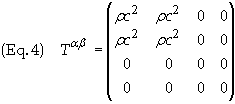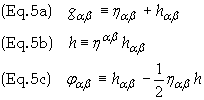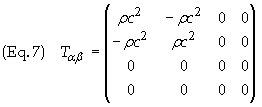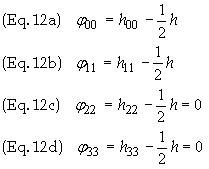
The Gravitational Field of a
Directed Beam of Light
Back
to Physics World
Back
to General Relativity
The energy density for an
electromagnetic field is given by

The electric and magnetic fields are related to the electric potential, F, and the magnetic vector potential, a, through Maxell's equations, which in differential form are given by

A
is the 4-potential whose components Aa,
is used to define the components, Fab,
of the Faraday tensor F. The stress-energy-momentum (SEM) tensor for the
electromagnetic field, and the components of the Faraday tensor are defined,
respectively, as

Using coordinates such that xm =(ct, x, y, z), the Stress-Energy-Momentum (SEM) tensor, for radiation propagating in the +x direction, in Eq. (3b) becomes

Let
hab
º
diag (1, -1, -1, -1) = hab.
Define the following quantities

The
linearized Einstein field equations are [4]
![]()
where
Tab
= hamhbnTmn,
which, for a directed
beam, is

Assuming time independent matter distributions (no retardation effects are present) the solution to Eq. 11 is [2]
![]()
Substituting the values T00 = rc2, T01 = -rc2, T11 = rc2, for the SEM tensor we get



f12
= f13
= f22
= f23
= 0. Applying these
values to the definition of fab,
i.e. Eq. (5a), give

h22+ h33+ h = 0 => h22+ h33 = -h =0
Evaluate h by
substituting the values above
h
º habhab
= h00
– h11
- h22
- h33
= h00
– h11
– (h22
+h33)
= h00
– h11
+ h = 0
which implies h00 = h11. This and the relations above yield the solution
h00=
f00,
h01
= -f00,
h02
=
h12
= h13
= h23
=
h22
=
h33
=
0
The metric may therefore be represented solely in terms or h00= f00

For a thin beam of radiation along the z-axis with a linear mass density r the value f00 is then found to be (r2 º x2 + y2)

Motion of Light Ray: In order to arrive at an expression for the velocity of a light ray in this gravitational field, defined by the metric in Eq. 18, first write out the corresponding expression for the spacetime interval
![]()
Since a light rays move on null geodesics set ds2= 0. After dividing through by cdt Eq. 20 becomes
![]()
where bx º vx /c etc. Let initial velocity of the test ray be in the direction parallel to the x-axis. Then, initially, by = bz = 0. With these values Eq. 22 has two solutions

Since
we started with the assumption h00
<< 1 the quantity in the brackets in the second equation is positive and
therefore vx is negative.
Therefore a test light ray moving in the +x direction, the same
direction as the flow of radiation has the same speed regardless of where in the
field the ray is located. If the ray is moving in the opposite direction the
speed of light depends on the spatial coordinates as is usual for motion if a
gravitational field.
References:
[1]
On The Gravitational Field Produced by Light,
Tolman, Ehrenfest and Podolsky, Physical Review, Vol. (37), March 1, 1931, pg
602-615.
[2] Relativity,
Thermodynamics and Cosmology, Richard C. Tolman, Dover Pub,
Sections 112-115 cover more aspects of the gravitational field generated by
light than is presented here.
[3] Relativity; Special, General and Cosmological, Wolfgang Rindler, Oxford
University Press, pg. 322, Eq. 15.28
[4] Ref. 3, pg. 321, Eq. 15.27
Back to General Relativity
Back
to Physics World
![]()
![]()